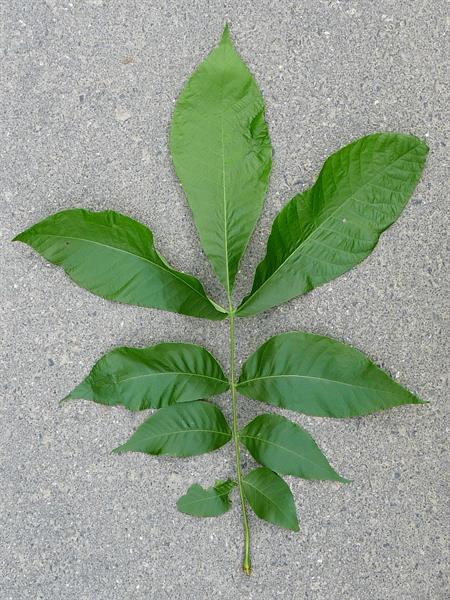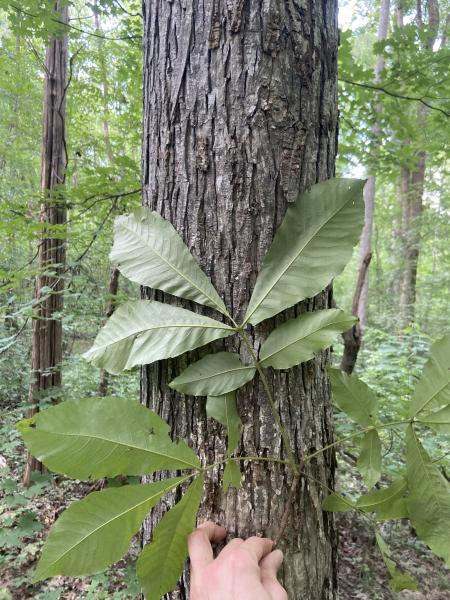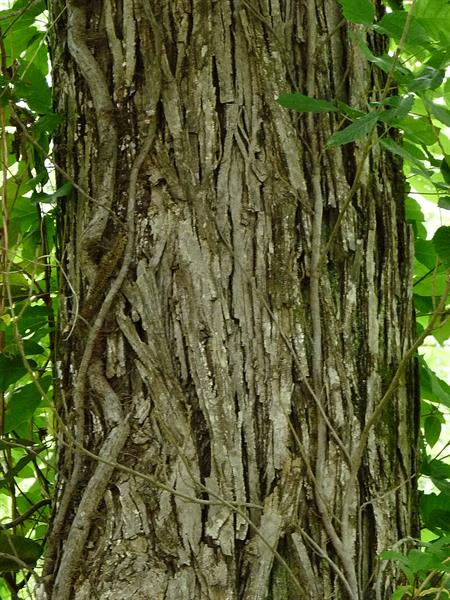
ID notes:Leaf rachises tend to curl up and persist throughout the winter (bare of leaflets, which senesce and drop), creating a distinctive look.
Origin/Endemic status: Native
Other Comments: This species is sometimes planted, but occurs native in nw. GA, along the Roanoke River (Halifax and Northampton counties, NC) and New Hope Creek (Durham County, NC).
Synonymy: = Ar, C, F, FNA3, G, GrPl, GW2, Il, K1, K3, K4, Mi, NE, NY, Pa, RAB, Tn, Tx, W; = Hicoria laciniosa (F.Michx.) Sarg. – S, S13
Wetland Indicator Status:
- Atlantic and Gulf Coastal Plain: FAC (taxonomic lump from wetland indicator species)
- Atlantic and Gulf Coastal Plain: FACW (taxonomic lump from wetland indicator species)
- Eastern Mountains and Piedmont: FAC
- Great Plains: FAC
- Midwest: FACW
- Northcentral & Northeast: FACW
Heliophily: 5
Hover over a shape, letter, icon, or arrow on the map for definition or see the legend.
 © Richard & Teresa Ware CC-BY-NC, permission granted to NCBG | Original Image ⭷
© Richard & Teresa Ware CC-BY-NC, permission granted to NCBG | Original Image ⭷ © Scott Ward, some rights reserved (CC BY), uploaded by Scott Ward source CC-BY | Original Image ⭷
© Scott Ward, some rights reserved (CC BY), uploaded by Scott Ward source CC-BY | Original Image ⭷ © Scott Ward, some rights reserved (CC BY), uploaded by Scott Ward source CC-BY | Original Image ⭷
© Scott Ward, some rights reserved (CC BY), uploaded by Scott Ward source CC-BY | Original Image ⭷ © Richard & Teresa Ware CC-BY-NC, permission granted to NCBG | Original Image ⭷
© Richard & Teresa Ware CC-BY-NC, permission granted to NCBG | Original Image ⭷ © Scott Ward, some rights reserved (CC BY), uploaded by Scott Ward source CC-BY | Original Image ⭷
© Scott Ward, some rights reserved (CC BY), uploaded by Scott Ward source CC-BY | Original Image ⭷ © Erik Danielson source | Original Image ⭷
© Erik Danielson source | Original Image ⭷ © Richard & Teresa Ware CC-BY-NC, permission granted to NCBG | Original Image ⭷
© Richard & Teresa Ware CC-BY-NC, permission granted to NCBG | Original Image ⭷ © Richard & Teresa Ware CC-BY-NC, permission granted to NCBG | Original Image ⭷
© Richard & Teresa Ware CC-BY-NC, permission granted to NCBG | Original Image ⭷ © Erik Danielson source | Original Image ⭷
© Erik Danielson source | Original Image ⭷Feedback
See something wrong or missing on about Carya laciniosa? Let us know here: (Please include your name and email if at all complicated so we can clarify if needed.)
Cite as...